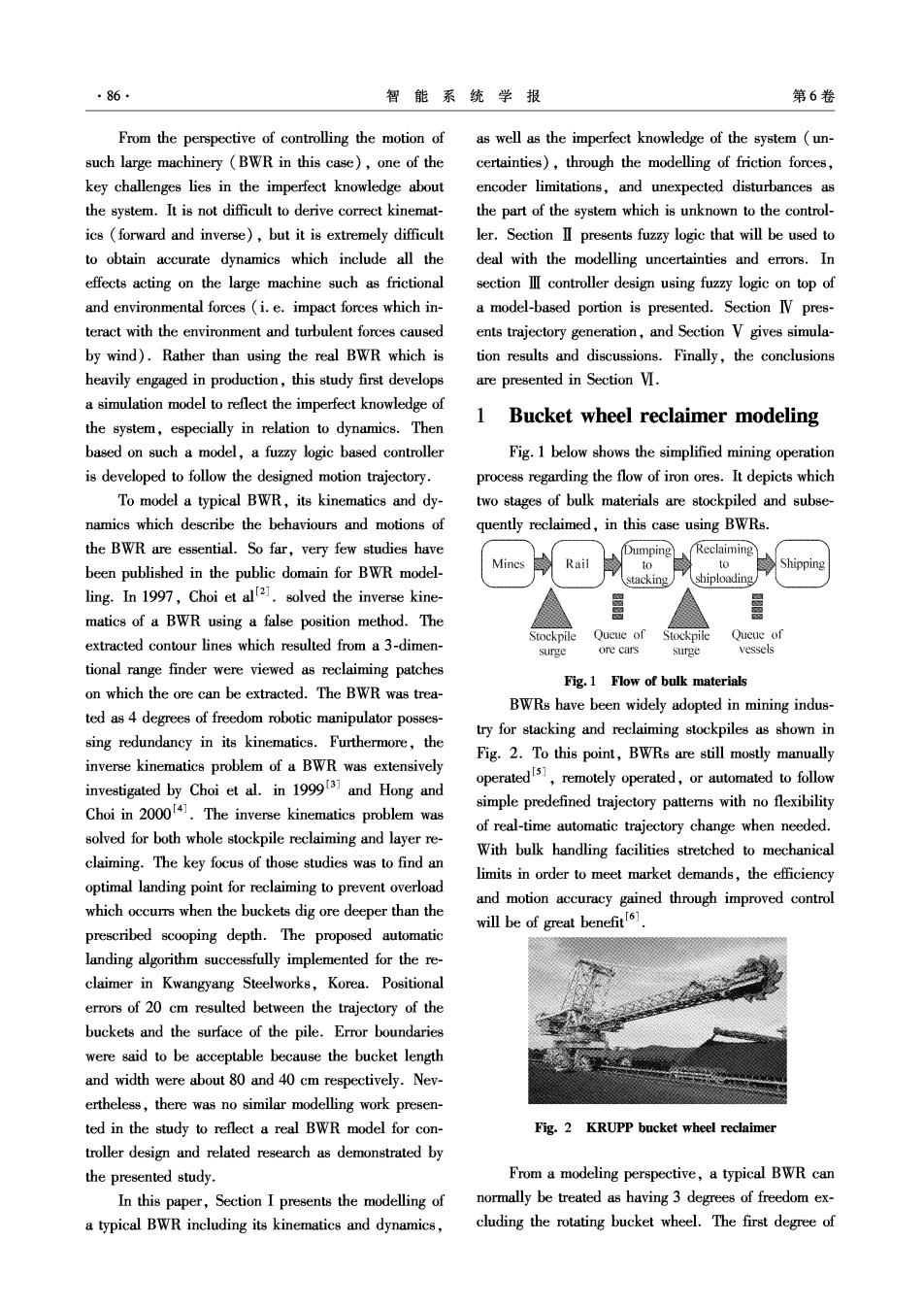正在加载图片...

86 智能系统学报 第6卷 From the perspective of controlling the motion of as well as the imperfect knowledge of the system (un- such large machinery (BWR in this case),one of the certainties),through the modelling of friction forces, key challenges lies in the imperfect knowledge about encoder limitations,and unexpected disturbances as the system.It is not difficult to derive correct kinemat- the part of the system which is unknown to the control- ics (forward and inverse),but it is extremely difficult ler.Section II presents fuzzy logic that will be used to to obtain accurate dynamics which include all the deal with the modelling uncertainties and errors.In effects acting on the large machine such as frictional section II controller design using fuzzy logic on top of and environmental forces (i.e.impact forces which in- a model-based portion is presented.Section IV pres- teract with the environment and turbulent forces caused ents trajectory generation,and Section V gives simula- by wind).Rather than using the real BWR which is tion results and discussions.Finally,the conclusions heavily engaged in production,this study first develops are presented in Section VI. a simulation model to reflect the imperfect knowledge of 1 Bucket wheel reclaimer modeling the system,especially in relation to dynamics.Then based on such a model,a fuzzy logic based controller Fig.1 below shows the simplified mining operation is developed to follow the designed motion trajectory. process regarding the flow of iron ores.It depicts which To model a typical BWR,its kinematics and dy- two stages of bulk materials are stockpiled and subse- namics which describe the behaviours and motions of quently reclaimed,in this case using BWRs. the BWR are essential.So far,very few studies have Dumping Reclaiming been published in the public domain for BWR model- Rail to to Shipping stacking shiploading/ ling.In 1997,Choi et alt2.solved the inverse kine- matics of a BWR using a false position method.The extracted contour lines which resulted from a 3-dimen- Stockpile Queue of Stockpile Queue of surge ore cars surge vessels tional range finder were viewed as reclaiming patches Fig.1 Flow of bulk materials on which the ore can be extracted.The BWR was trea- BWRs have been widely adopted in mining indus- ted as 4 degrees of freedom robotic manipulator posses- try for stacking and reclaiming stockpiles as shown in sing redundancy in its kinematics.Furthermore,the Fig.2.To this point,BWRs are still mostly manually inverse kinematics problem of a BWR was extensively investigated by Choi et al.in 199913 and Hong and operatedis,remotely operated,orautomted to follow Choi in 2000141.The inverse kinematics problem was simple predefined trajectory patterns with no flexibility of real-time automatic trajectory change when needed. solved for both whole stockpile reclaiming and layer re- With bulk handling facilities stretched to mechanical claiming.The key focus of those studies was to find an limits in order to meet market demands,the efficiency optimal landing point for reclaiming to prevent overload and motion accuracy gained through improved control which occurrs when the buckets dig ore deeper than the will be of great benefit1. prescribed scooping depth.The proposed automatic landing algorithm successfully implemented for the re- claimer in Kwangyang Steelworks,Korea.Positional errors of 20 cm resulted between the trajectory of the buckets and the surface of the pile.Error boundaries were said to be acceptable because the bucket length and width were about 80 and 40 cm respectively.Nev- ertheless,there was no similar modelling work presen- ted in the study to reflect a real BWR model for con- Fig.2 KRUPP bucket wheel reclaimer troller design and related research as demonstrated by the presented study. From a modeling perspective,a typical BWR can In this paper,Section I presents the modelling of normally be treated as having 3 degrees of freedom ex- a typical BWR including its kinematics and dynamics, cluding the rotating bucket wheel.The first degree of